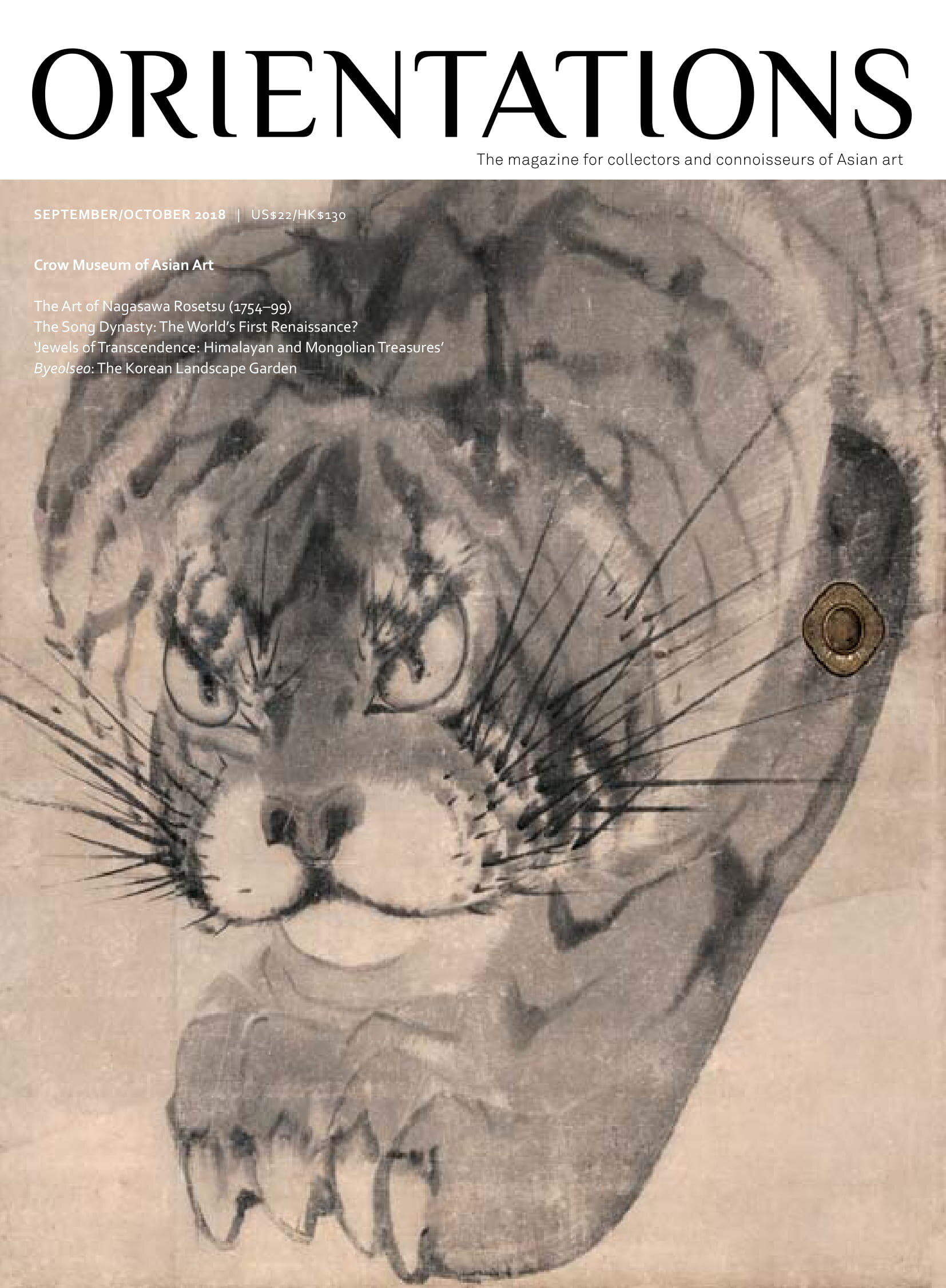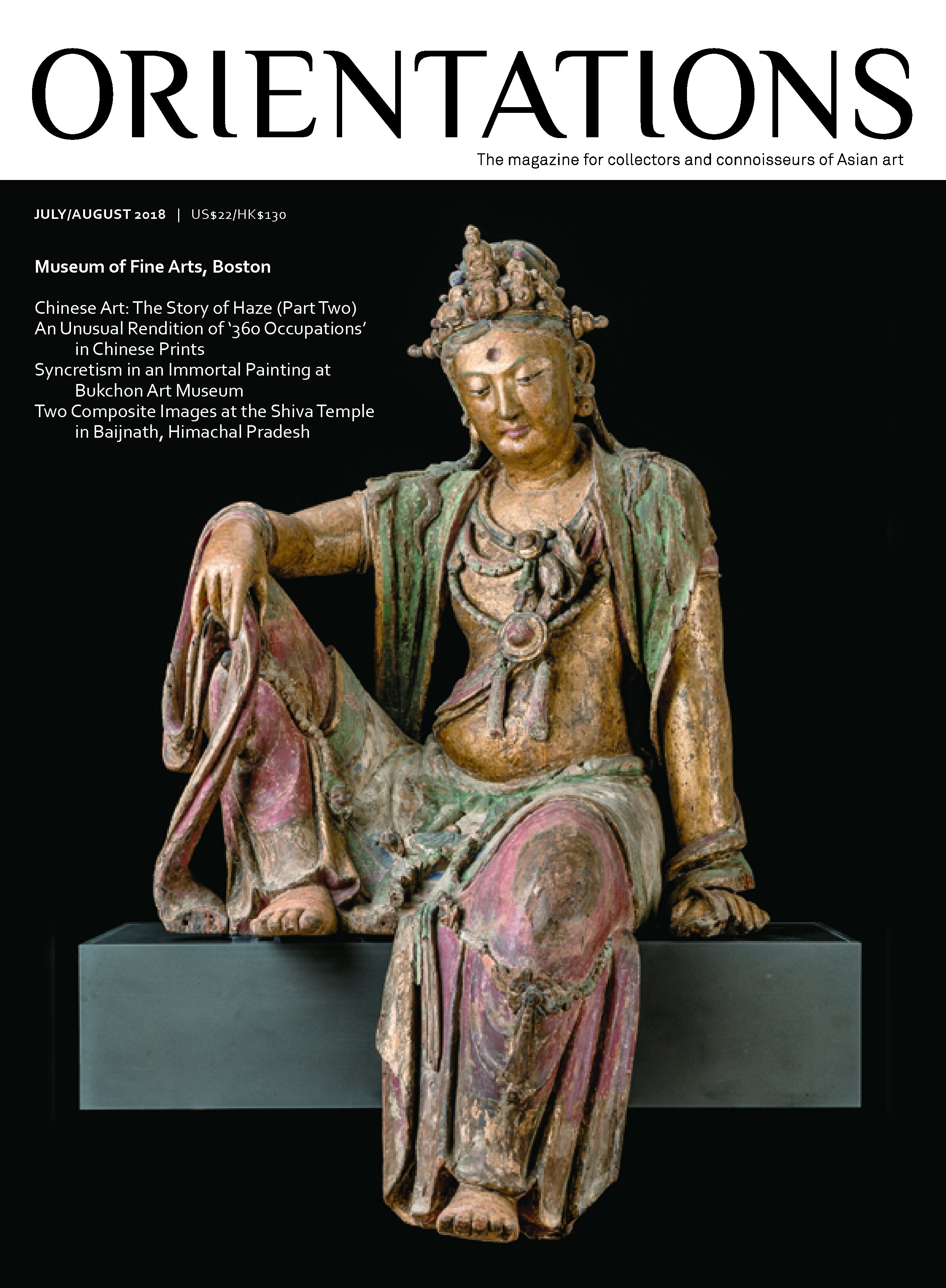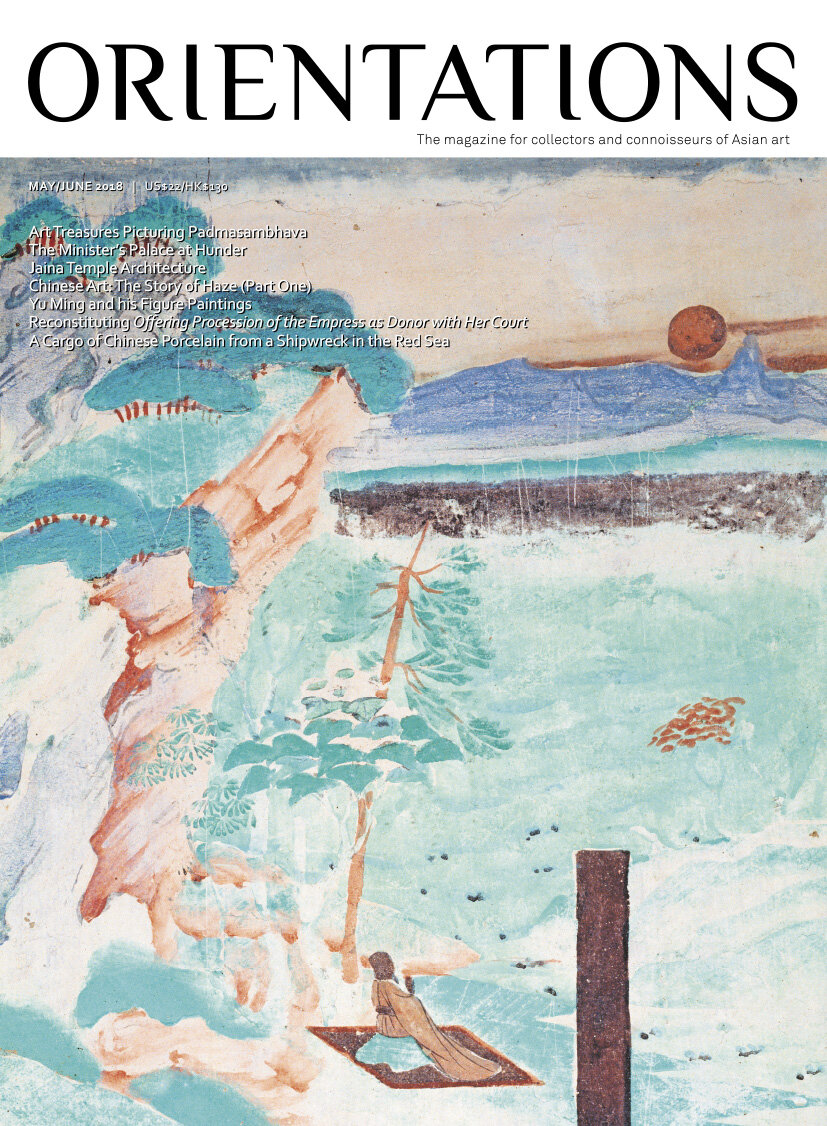JAN/FEB 2018
VOLUME 49 - NUMBER 1
We start the New Year with a groundbreaking exhibition— ‘Power and Beauty in China’s Last Dynasty’ at the Minneapolis Institute of Art (Mia). Focusing on costumes and other works made for the court, the show is innovative in being designed in partnership with visual artist and theatre director Robert Wilson. The installation, which is accompanied by sound effects, employs the contrasts of darkness and brightness, emptiness and fullness to immerse visitors in the realm of the Qing court. Mia’s deputy director and chief curator Matthew Welch relates the background to the show, while Chinese art curator Liu Yang guides us through the display.
Next, An-yi Pan looks at the growth of post-war Taiwan modern art and the evolution of the Fifth Moon Group, which was resurrected in the 1990s and featured 36 painters in its 2017 show; Soyoung Lee presents a 19th century painting of the Diamond Mountains in Korea that was recently acquired by The Met and will be on view in 2018; and Rachel Parikh explains the sacred roles of weaponry in Hindu belief.
The Cleveland Museum of Art is home to a 6th century image of Shakyamuni, long thought to have been the oldest metal Buddha made in Nepal. In ‘New Perspectives’, Aurora Graldi re-examines this view, concluding that the statue was in fact cast in northeast India. Peng Peng considers the manufacturing technique of the bronze zun-pan set from the tomb of Marquis Yi. And Divya Kumar-Dumas introduces Sigiriya, perhaps one of the oldest gardens known in Asia.
FEATURES
Matthew Welch. The Making of ‘Power and Beauty in China’s Last Dynasty’: A New Approach
Liu Yang. Where Dragons Dwell: ‘Power and Beauty in China’s Last Dynasty’
An-yi Pan. The Fifth Moon Group: Pioneers of New Chinese Modern Art in Taiwan
Soyoung Lee. A Pictorial Journey through the Diamond Mountains
Rachel Parikh. The Forged and The Divine: Weapons and Goddess Worship in Hinduism
Aurora Graldi. Travelling Icons and Travelling Donors: A Metal Buddha Image in The Cleveland Museum of Art
Peng Peng. Was the Lost-wax Technique Adopted in Pre-Qin Chinese Bronze Art?
Divya Kumar-Dumas. Sigiriya: An Early Designed Landscape in Sri Lanka
Curator's Choice. A Journey from Medieval France to Goryeo Korea and Song China by Robert D. Mowry
Emerging Voices – Rhiannon Paget
PREVIEWS & REVIEWS
Yuka Kadoi. Book Review: Magic and Divination in Malay Illustrated Manuscripts by Farouk Yahya
INTERVIEWS
Jacqueline Chao. Sopheap Pich: Inspirations and Reflections
NEWS
Announcements
VOLUME 49 - NUMBER 1
We start the New Year with a groundbreaking exhibition— ‘Power and Beauty in China’s Last Dynasty’ at the Minneapolis Institute of Art (Mia). Focusing on costumes and other works made for the court, the show is innovative in being designed in partnership with visual artist and theatre director Robert Wilson. The installation, which is accompanied by sound effects, employs the contrasts of darkness and brightness, emptiness and fullness to immerse visitors in the realm of the Qing court. Mia’s deputy director and chief curator Matthew Welch relates the background to the show, while Chinese art curator Liu Yang guides us through the display.
Next, An-yi Pan looks at the growth of post-war Taiwan modern art and the evolution of the Fifth Moon Group, which was resurrected in the 1990s and featured 36 painters in its 2017 show; Soyoung Lee presents a 19th century painting of the Diamond Mountains in Korea that was recently acquired by The Met and will be on view in 2018; and Rachel Parikh explains the sacred roles of weaponry in Hindu belief.
The Cleveland Museum of Art is home to a 6th century image of Shakyamuni, long thought to have been the oldest metal Buddha made in Nepal. In ‘New Perspectives’, Aurora Graldi re-examines this view, concluding that the statue was in fact cast in northeast India. Peng Peng considers the manufacturing technique of the bronze zun-pan set from the tomb of Marquis Yi. And Divya Kumar-Dumas introduces Sigiriya, perhaps one of the oldest gardens known in Asia.
FEATURES
Matthew Welch. The Making of ‘Power and Beauty in China’s Last Dynasty’: A New Approach
Liu Yang. Where Dragons Dwell: ‘Power and Beauty in China’s Last Dynasty’
An-yi Pan. The Fifth Moon Group: Pioneers of New Chinese Modern Art in Taiwan
Soyoung Lee. A Pictorial Journey through the Diamond Mountains
Rachel Parikh. The Forged and The Divine: Weapons and Goddess Worship in Hinduism
Aurora Graldi. Travelling Icons and Travelling Donors: A Metal Buddha Image in The Cleveland Museum of Art
Peng Peng. Was the Lost-wax Technique Adopted in Pre-Qin Chinese Bronze Art?
Divya Kumar-Dumas. Sigiriya: An Early Designed Landscape in Sri Lanka
Curator's Choice. A Journey from Medieval France to Goryeo Korea and Song China by Robert D. Mowry
Emerging Voices – Rhiannon Paget
PREVIEWS & REVIEWS
Yuka Kadoi. Book Review: Magic and Divination in Malay Illustrated Manuscripts by Farouk Yahya
INTERVIEWS
Jacqueline Chao. Sopheap Pich: Inspirations and Reflections
NEWS
Announcements
VOLUME 49 - NUMBER 1
We start the New Year with a groundbreaking exhibition— ‘Power and Beauty in China’s Last Dynasty’ at the Minneapolis Institute of Art (Mia). Focusing on costumes and other works made for the court, the show is innovative in being designed in partnership with visual artist and theatre director Robert Wilson. The installation, which is accompanied by sound effects, employs the contrasts of darkness and brightness, emptiness and fullness to immerse visitors in the realm of the Qing court. Mia’s deputy director and chief curator Matthew Welch relates the background to the show, while Chinese art curator Liu Yang guides us through the display.
Next, An-yi Pan looks at the growth of post-war Taiwan modern art and the evolution of the Fifth Moon Group, which was resurrected in the 1990s and featured 36 painters in its 2017 show; Soyoung Lee presents a 19th century painting of the Diamond Mountains in Korea that was recently acquired by The Met and will be on view in 2018; and Rachel Parikh explains the sacred roles of weaponry in Hindu belief.
The Cleveland Museum of Art is home to a 6th century image of Shakyamuni, long thought to have been the oldest metal Buddha made in Nepal. In ‘New Perspectives’, Aurora Graldi re-examines this view, concluding that the statue was in fact cast in northeast India. Peng Peng considers the manufacturing technique of the bronze zun-pan set from the tomb of Marquis Yi. And Divya Kumar-Dumas introduces Sigiriya, perhaps one of the oldest gardens known in Asia.
FEATURES
Matthew Welch. The Making of ‘Power and Beauty in China’s Last Dynasty’: A New Approach
Liu Yang. Where Dragons Dwell: ‘Power and Beauty in China’s Last Dynasty’
An-yi Pan. The Fifth Moon Group: Pioneers of New Chinese Modern Art in Taiwan
Soyoung Lee. A Pictorial Journey through the Diamond Mountains
Rachel Parikh. The Forged and The Divine: Weapons and Goddess Worship in Hinduism
Aurora Graldi. Travelling Icons and Travelling Donors: A Metal Buddha Image in The Cleveland Museum of Art
Peng Peng. Was the Lost-wax Technique Adopted in Pre-Qin Chinese Bronze Art?
Divya Kumar-Dumas. Sigiriya: An Early Designed Landscape in Sri Lanka
Curator's Choice. A Journey from Medieval France to Goryeo Korea and Song China by Robert D. Mowry
Emerging Voices – Rhiannon Paget
PREVIEWS & REVIEWS
Yuka Kadoi. Book Review: Magic and Divination in Malay Illustrated Manuscripts by Farouk Yahya
INTERVIEWS
Jacqueline Chao. Sopheap Pich: Inspirations and Reflections
NEWS
Announcements






